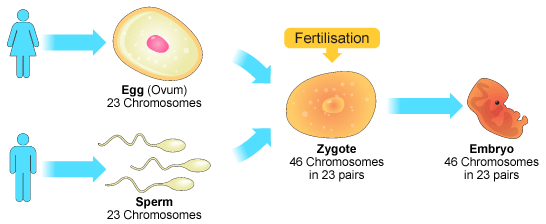In the process of sexual reproduction, new organisms are created by the combination of genetic information, from the two parents of the different sexes. Chromosomes present in the gametes which are the specialized sex cells carries the genetic information. The gametes of females are eggs and gametes of the males are sperms. During the process of sexual reproduction, the two gametes are joined together by the fusion process, known as fertilization. A zygote is created in this process, which is a precursor to the embryo of the offspring. The embryo takes DNA from both of the parents.

Genotypes such as the resistance to the diseases and the phenotypic traits such as the physical adaptations of the organisms to the environments are passed from the parents to the daughter individuals during sexual reproduction. In sexual reproduction, there is the drive of the evolution process. By this type of reproduction, phenotypic and genotypic diversity is increased within the given population and it allows the natural selection for selecting the best-suited individuals to the environment.
Types of Sexual Reproduction
Allogamy, internal fertilization, external fertilization, and autogamy are well-known examples of sexual reproduction. Allogamy occurs by the joining of gametes from the two different individuals during the fertilization. In the internal fertilization, the egg is fertilized by the sperm in the body of one of the parents. Whereas, in the external fertilization, the sperm fertilizes the egg outside the body of parents. Autogamy is also known as self-pollination or self-fertilization and it involves the fusion of female and male gametes.
Advantages of Sexual Reproduction
Through the cell miosis, deleterious mutations can accumulate within the parts of DNA over time. In sexual reproduction, there is a combination of DNA from both of the parents, so, only one portion of deleterious mutations are passed to the new offspring, thus increasing the chances of their survival. By the natural selection this effect is increased and the individuals in which the exceptionally harmful mutations are present, cannot pass their genes to the offspring by the sexual reproduction.
Disadvantages of Sexual Reproduction
- The number of populations that is capable of gestation is less than 50
- For each gender, it is a must to find a mate of the opposite sex.
- The viability of offspring can be determined by outside influences.
- Diseases can be transferred to other individuals by sexual reproduction.
- The reproduction is not always guaranteed.
- The best genetics is not always passed to the offspring.